Background Tests and Improvements at LAC-UFF Aiming at Sample Size Reduction in Foraminifera 14C Measurement
Abstract
:1. Introduction
2. Materials and Methods
3. Results
4. Discussion
5. Conclusions
Supplementary Materials
Author Contributions
Funding
Data Availability Statement
Acknowledgments
Conflicts of Interest
References
- Hedges, R.E. Progress in radiocarbon dating. Sci. Prog. 1933, 1985, 409–427. [Google Scholar]
- Hajdas, I.; Ascough, P.; Garnett, M.H.; Fallon, S.J.; Pearson, C.L.; Quarta, G.; Spalding, K.L.; Yamaguchi, H.; Yoneda, M. Radiocarbon dating. Nat. Rev. Methods Primers 2021, 1, 62. [Google Scholar]
- Moreira, V.; Macario, K.; Guimarães, R.; Dias, F.; Araujo, J.; Jesus, P.; Douka, K. Aragonite Fraction Dating of Vermetids in the Contex of Paleo Sea-Level Curves Reconstruction. Radiocarbon 2020, 62, 335–348. [Google Scholar] [CrossRef]
- Alves, E.Q.; Macario, K.; Ascough, P.; Ramsey, C.B. The Worldwide Marine Radiocarbon Reservoir Effect: Definitions, Mechanisms, and Prospects. Rev. Geophys. 2018, 56, 278–305. [Google Scholar] [CrossRef]
- Gupta, B.K. (Ed.) Modern Foraminifera; Kluwer Academic Publishers: Dordrecht, Germany, 1999. [Google Scholar]
- Dolman, A.M.; Groeneveld, J.; Mollenhauer, G.; Ho, S.L.; Laepple, T. Estimating Bioturbation from Replicated Small-Sample Radiocarbon Ages. Paleoceanogr. Paleoclimatol. 2021, 36, e2020PA004142. [Google Scholar] [CrossRef]
- Magana, A.L.; Southon, J.R.; Kennett, J.P.; Roark, E.B.; Sarnthein, M.; Stott, L.D. Resolving the cause of large differences between deglacial benthic foraminifera radiocarbon measurements in Santa Barbara Basin. Paleoceanography 2010, 25, PA4102. [Google Scholar] [CrossRef]
- Missiaen, L.; Wacker, L.; Lougheed, B.C.; Skinner, L.; Hajdas, I.; Nouet, J.; Pichat, S.; Waelbroeck, C. Radiocarbon Dating of Small-sized Foraminifer Samples: Insights into Marine sediment Mixing. Radiocarbon 2020, 62, 313–333. [Google Scholar] [CrossRef]
- Dias-Brito, D. A micropaleontologia na indústria do petróleo. Rev. Bras. Geociências 1989, 19, 256–259. [Google Scholar] [CrossRef]
- Petró, S.M.; Pivel, M.A.G.; Coimbra, J.C. Implicações da dissolução de carbonato de cálcio pelágico em reconstruções paleoceanográficas do Quaternário. Quat. Environ. Geosci. 2016, 7, 14–25. [Google Scholar]
- Pearson, A.; McNichol, A.P.; Schneider, R.J.; von Reden, K.F.; Zheng, Y. Microscale 14C AMS measurement at NOSAMS. Radicarbon 1998, 40, 61–75. [Google Scholar] [CrossRef]
- Schleicher, M.; Grootes, P.M.; Nadeau, M.-J.; Schoon, A. The Carbonate 14C Background and its Components at the Leibniz AMS Facility. Radiocarbon 1997, 40, 85–93. [Google Scholar] [CrossRef]
- Hua, Q.; Jacobsen, G.E.; Zoppi, U.; Lawson, E.M.; Williams, A.A.; Smith, A.M.; McGann, M.J. Progress in radiocarbon tar-get preparation at the ANTARES AMS Centre. Radiocarbon 2001, 43, 275–282. [Google Scholar] [CrossRef]
- Santos, G.M.; Moore, R.B.; Southon, J.R.; Griffin, S.; Hinger, E.; Zhang, D. AMS 14C Sample Preparation at the KCCAMS/UCI Facility: Status Report and Performance of Small Samples. Radiocarbon 2007, 49, 255–269. [Google Scholar] [CrossRef]
- Santos, G.M.; Southon, J.R.; Griffin, S.; Beaupre, S.R.; Druffel, E.R.M. Ultra small-mass AMS 14C sample preparation and analyses at KCCAMS/UCI facility. Nucl. Instrum. Methods Phys. Res. B 2007, 259, 293–302. [Google Scholar] [CrossRef]
- Ruff, M.; Szidat, S.; Gäggeler, H.W.; Suter, M.; Synal, H.; Wacker, L. Gaseous radiocarbon measurements of small samples. Nucl. Instrum. Methods Phys. Res. B 2010, 268, 790–794. [Google Scholar] [CrossRef]
- Smith, A.M.; Yang, B.; Hua, Q.; Mann, M. Laser-Heated Microfurnace: Gas Analysis and Graphite Morphology. Radiocarbon 2010, 52, 769–782. [Google Scholar] [CrossRef]
- Delqué-Količ, E.; Comby-Zerbino, C.; Ferkane, S.; Moreau, C.; Dumoulin, J.; Caffy, I.; Souprayen, C.; Quilès, A.; Bavay, D.; Hain, S.; et al. Preparing and measuring ultra-small radiocarbon samples with the ARTEMIS AMS facility in Saclay, France. Nucl. Instrum. Methods Phys. Res. Sect. B Beam Interact. Mater. At. 2013, 294, 189–193. [Google Scholar] [CrossRef]
- Yokoyama, Y.; Koizumi, M.; Matsuzaki, H.; Miyairi, Y.; Ohkouchi, N. Developing Ultra Small-Scale Radiocarbon Sample Measurement at the University of Tokyo. Radiocarbon 2010, 52, 310–318. [Google Scholar] [CrossRef]
- Uchida, M.; Shibata, Y.; Yoneda, M.; Kobayashi, T.; Morita, M. Technical progress in AMS microscale radiocarbon analysis. Nucl. Instrum. Methods Phys. Res. Sect. B Beam Interact. Mater. At. 2004, 223, 313–317. [Google Scholar] [CrossRef]
- Wacker, L.; Fahrni, S.; Hajdas, I.; Molnar, M.; Synal, H.-A.; Szidat, S.; Zhang, Y. A versatile gas interface for routine radiocarbon analysis with a gas ion source. Nucl. Instrum. Methods Phys. Res. Sect. B Beam Interact. Mater. At. 2013, 294, 315–319. [Google Scholar] [CrossRef]
- Szidat, S.; Vogel, E.; Gubler, R.; Lösch, S. Radiocarbon Dating of Bones at the LARA Laboratory in Bern, Switzerland. Radiocarbon 2014, 59, 831–842. [Google Scholar] [CrossRef]
- Walter, S.R.S.; Gagnon, A.R.; Roberts, M.L.; McNichol, A.P.; Gaylord, M.C.L.; Klein, E. Ultra-small graphitization reactors for ultra-microscale 14C analysis of the National Ocean Sciences Accelerator Mass Spectrometry (NOSAMS) facility. Radiocarbon 2015, 57, 109–122. [Google Scholar] [CrossRef]
- Wacker, L.; Bonani, G.; Friedrich, M.; Hajdas, I.; Kromer, B.; Němec, M.; Ruff, M.; Suter, M.; Synal, H.-A.; Vockenhuber, C. MICADAS: Routine and High-Precision Radiocarbon Dating. Radiocarbon 2010, 52, 252–262. [Google Scholar] [CrossRef]
- Ruff, M.; Fahrni, S.; Gäggeler, H.W.; Hajdas, I.; Suter, M.; Synal, H.A.; Szidat, S.; Wacker, L. On-line radiocarbon meas-urements of small samples using elemental analyzer and MICADAS gas ion source. Radiocarbon 2010, 52, 1645–1656. [Google Scholar] [CrossRef]
- Wacker, L.; Lippold, J.; Molnár, M.; Schulz, H. Towards radiocarbon dating of single foraminifera with a gas ion source. Nucl. Instrum. Methods Phys. Res. Sect. B Beam Interact. Mater. At. 2013, 294, 307–310. [Google Scholar] [CrossRef]
- Gottschalk, J.; Szidat, S.; Michel, E.; Mazaud, A.; Salazar, G.; Battaglia, M.; Lippold, J.; Jaccard, S.L. Radiocarbon Measurements of Small-Size Foraminiferal Samples with the Mini Carbon Dating System (MICADAS) at the University of Bern: Implications for Paleoclimate Reconstructions. Radiocarbon 2018, 60, 469–491. [Google Scholar] [CrossRef]
- Mueller, K.; Muzikar, P. Quantitative study of contamination effects in AMS 14C sample processing. Nucl. Instrum. Methods Phys. Res. Sect. B Beam Interact. Mater. At. 2002, 197, 128–133. [Google Scholar] [CrossRef]
- Von Reden, K.F.; McNichol, A.P.; Pearson, A.; Schneider, R.J. 14C measurements of <100 µg samples with a high-current system. Radiocarbon 1998, 40, 247–253. [Google Scholar]
- Khosh, M.S.; Xu, X.; Trumbore, S.E. Small-mass graphite preparation by sealed tube zinc reduction method for AMS 14C measurements. Nucl. Instrum. Methods Phys. Res. Sect. B Beam Interact. Mater. At. 2010, 268, 927–930. [Google Scholar] [CrossRef]
- Xu, X.; Trumbore, S.E.; Zheng, S.; Southon, J.R.; Mc Duffee, K.E.; Luttgen, M.; Liu, J.C. Modifying a sealed tube zinc reduction method for preparation of AMS graphite targets: Reducing background and attaining high precision. Nucl. Instrum. Methods Phys. Res. B 2007, 259, 320–329. [Google Scholar] [CrossRef]
- Rozanski, K. Consultants’ Group Meeting on 14C Reference Materials for Radiocarbon Laboratories, Vienna, Austria, 18–20 February 1991; Internal Report; IAEA: Vienna, Austria, 1991. [Google Scholar]
- Rozanski, K.; Stichler, W.; Gonfiantini, R.; Scott, E.M.; Beukens, R.P.; Kromer, B.; van der Plicht, J. Tha IAEA 14C intercomparison exercise. Radiocarbon 1992, 34, 506–519. [Google Scholar] [CrossRef]
- Steinhof, A.; Adamiec, G.; Gleixner, G.; Van Klinken, G.J.; Wagner, T. The new 14C analysis laboratory in Jena, Germany. Radiocarbon 2004, 46, 51–58. [Google Scholar] [CrossRef]
- Stuiver, M.; Polach, H.A. Discussion reporting of 14C data. Radiocarbon 1977, 19, 355–363. [Google Scholar] [CrossRef]
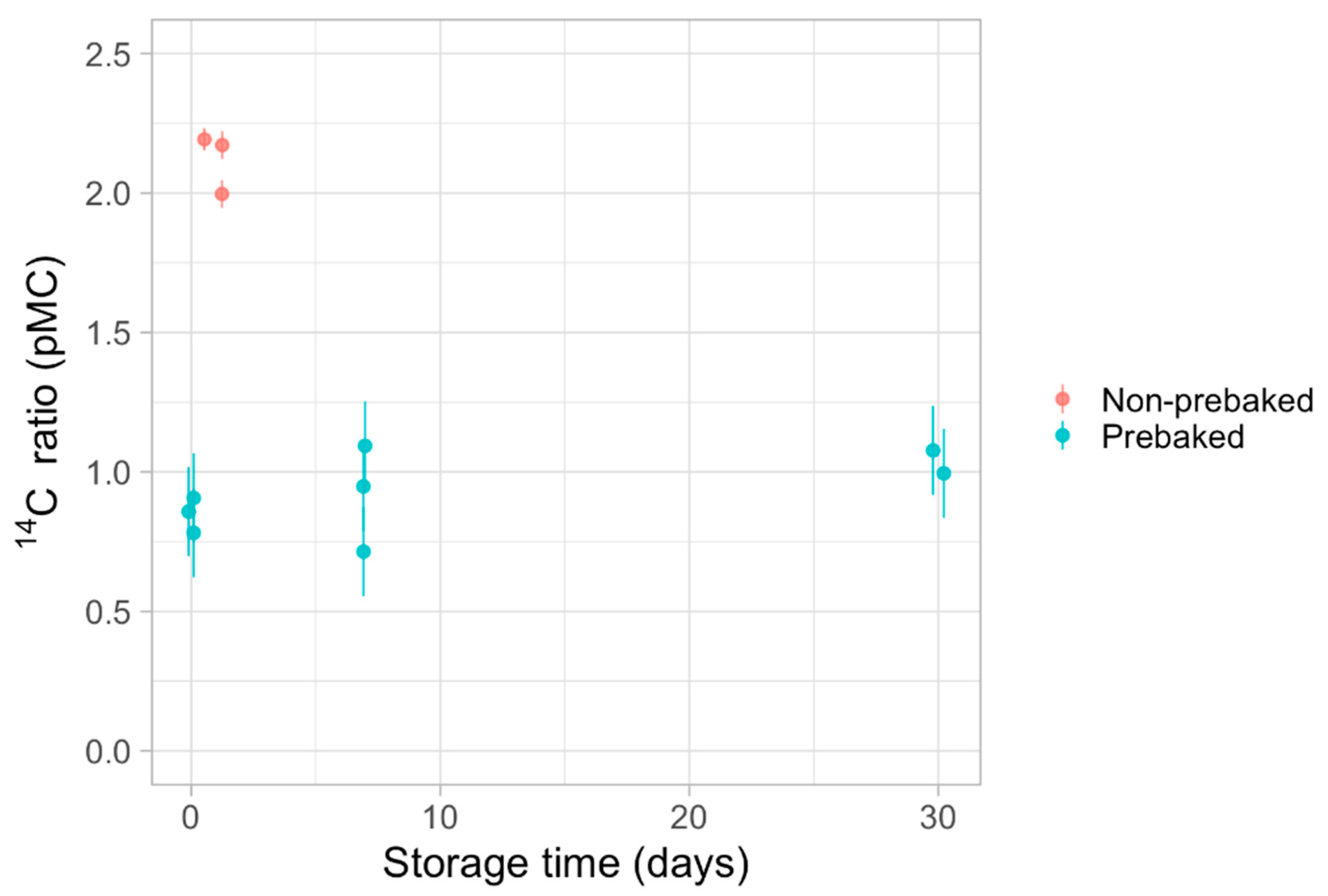
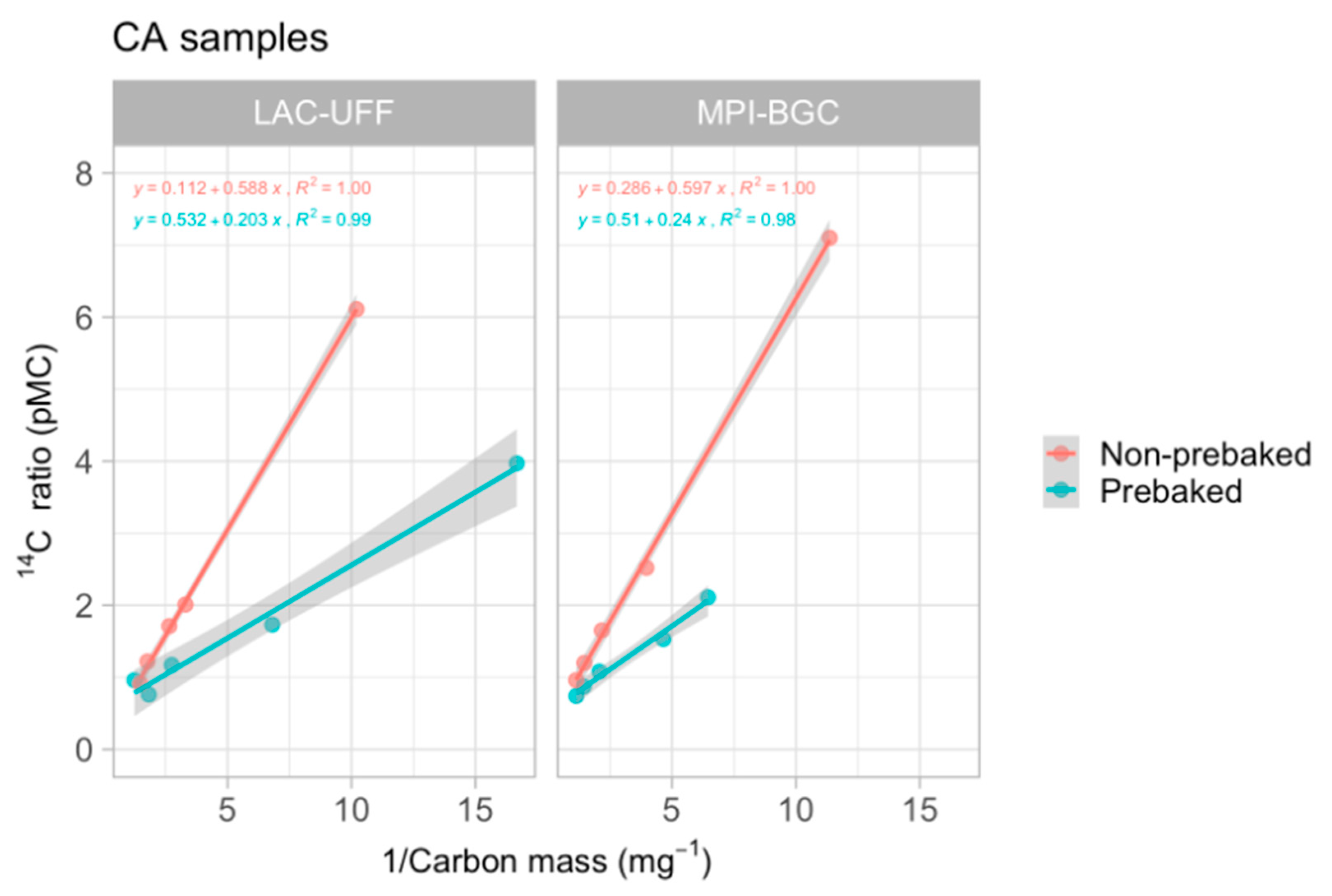
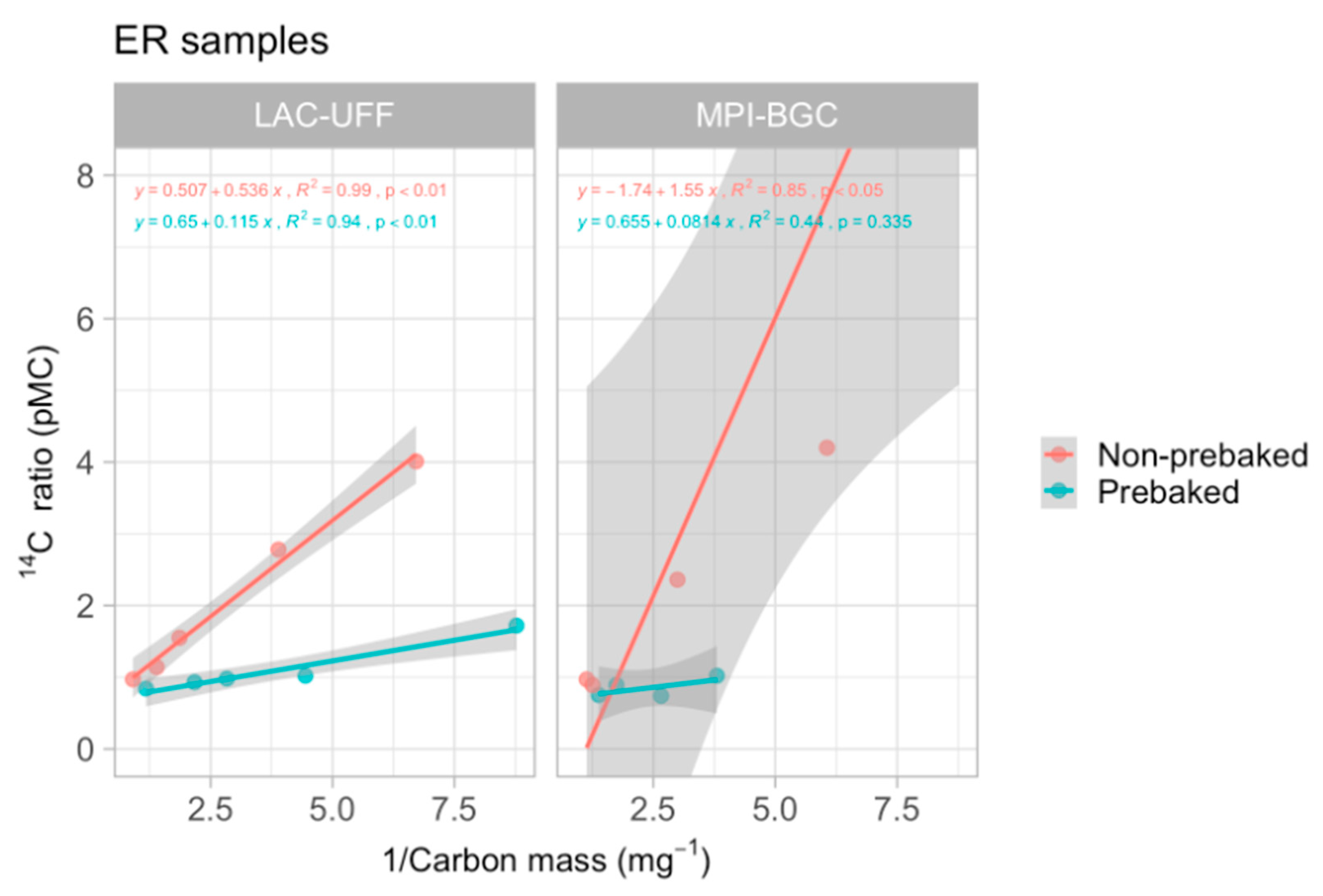
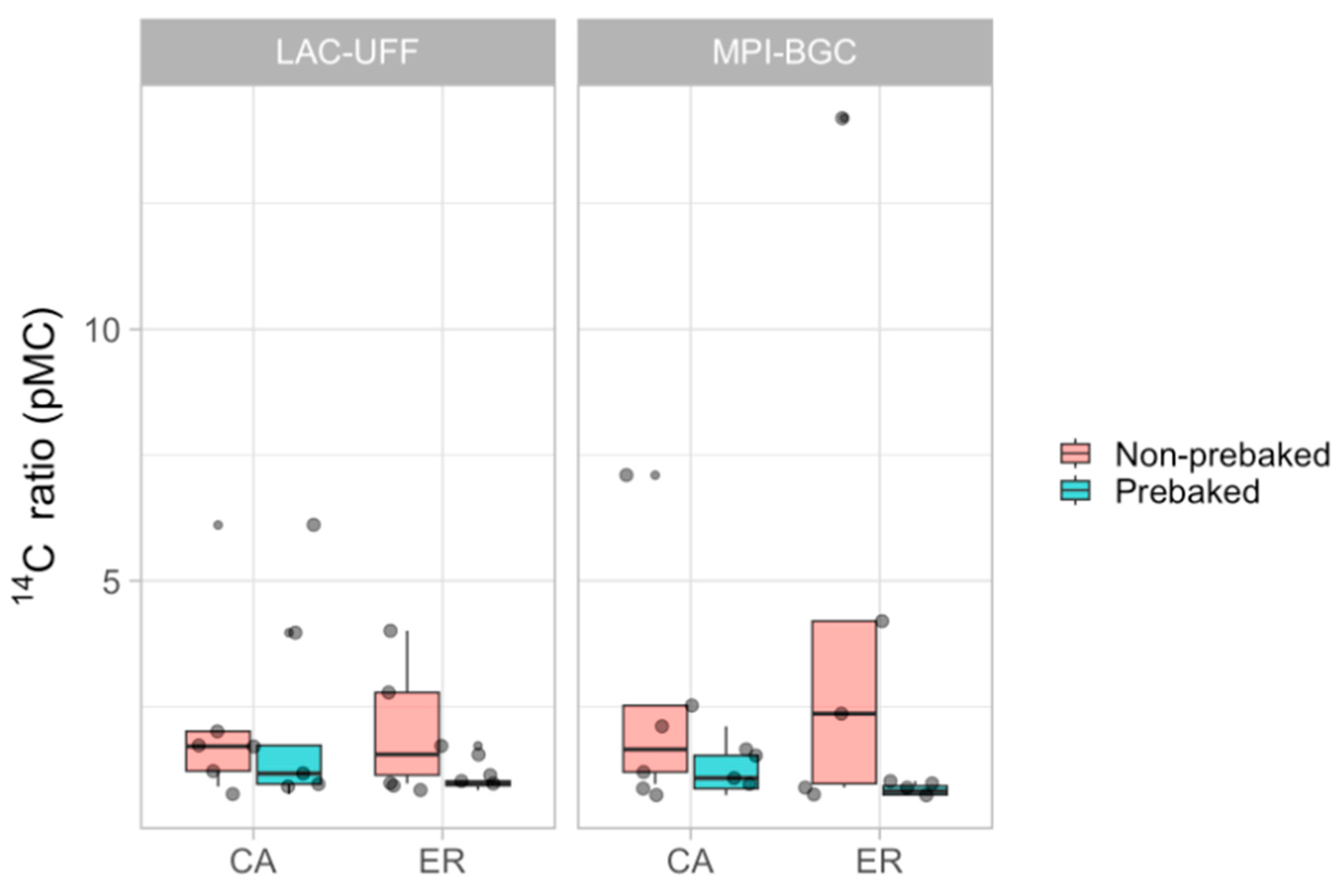

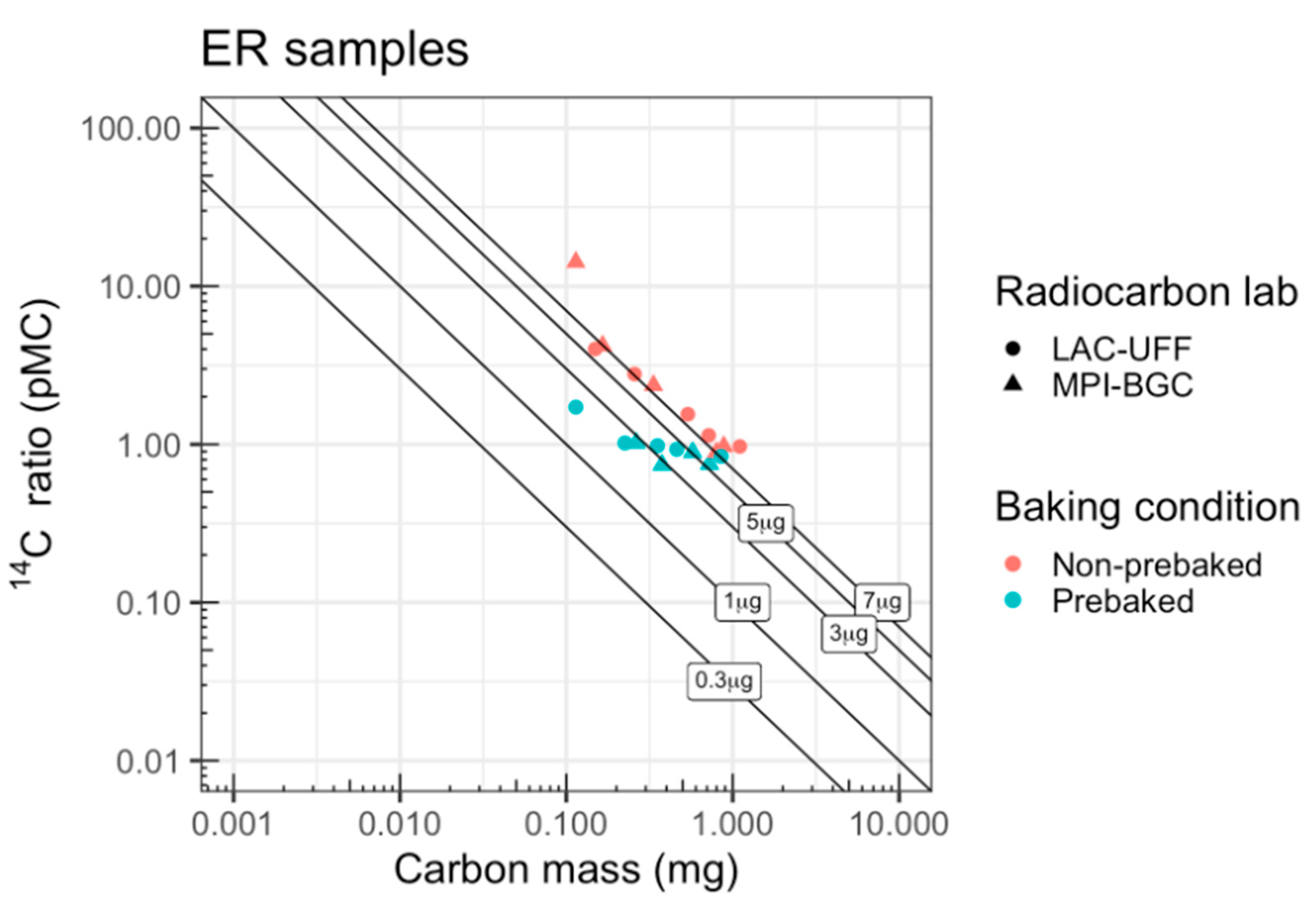

Disclaimer/Publisher’s Note: The statements, opinions and data contained in all publications are solely those of the individual author(s) and contributor(s) and not of MDPI and/or the editor(s). MDPI and/or the editor(s) disclaim responsibility for any injury to people or property resulting from any ideas, methods, instructions or products referred to in the content. |
© 2023 by the authors. Licensee MDPI, Basel, Switzerland. This article is an open access article distributed under the terms and conditions of the Creative Commons Attribution (CC BY) license (https://creativecommons.org/licenses/by/4.0/).
Share and Cite
Netto, B.M.; Macario, K.D.; Assumpção, A.; Diaz, M.; Fallon, S.J.; Xu, X.; Chanca, I.; Carvalho, C. Background Tests and Improvements at LAC-UFF Aiming at Sample Size Reduction in Foraminifera 14C Measurement. Geographies 2023, 3, 574-583. https://doi.org/10.3390/geographies3030030
Netto BM, Macario KD, Assumpção A, Diaz M, Fallon SJ, Xu X, Chanca I, Carvalho C. Background Tests and Improvements at LAC-UFF Aiming at Sample Size Reduction in Foraminifera 14C Measurement. Geographies. 2023; 3(3):574-583. https://doi.org/10.3390/geographies3030030
Chicago/Turabian StyleNetto, Bruna M., Kita D. Macario, Ayrton Assumpção, Maikel Diaz, Stewart J. Fallon, Xiaomei Xu, Ingrid Chanca, and Carla Carvalho. 2023. "Background Tests and Improvements at LAC-UFF Aiming at Sample Size Reduction in Foraminifera 14C Measurement" Geographies 3, no. 3: 574-583. https://doi.org/10.3390/geographies3030030
APA StyleNetto, B. M., Macario, K. D., Assumpção, A., Diaz, M., Fallon, S. J., Xu, X., Chanca, I., & Carvalho, C. (2023). Background Tests and Improvements at LAC-UFF Aiming at Sample Size Reduction in Foraminifera 14C Measurement. Geographies, 3(3), 574-583. https://doi.org/10.3390/geographies3030030








